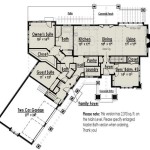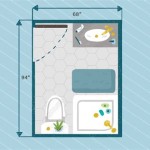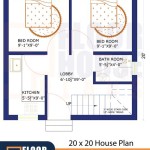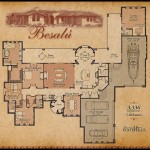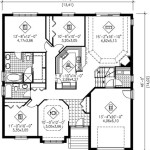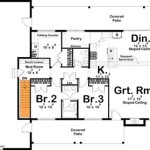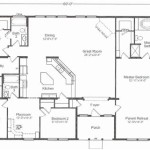Floor Plans For Mountain Homes: Optimizing Functionality and Aesthetics
Designing a mountain home requires careful consideration of various factors, including the terrain, climate, and desired lifestyle. The floor plan serves as the blueprint for creating a functional and aesthetically pleasing living space that seamlessly integrates with the surrounding natural environment. A well-designed mountain home floor plan accentuates views, maximizes natural light, and provides comfortable living spaces while withstanding unique environmental challenges.
Unlike typical suburban or urban dwellings, mountain homes often necessitate specialized floor plans due to varying elevation changes, potential for extreme weather, and the desire for privacy and connection with nature. Several key considerations influence the design process, demanding a balance between architectural ingenuity and practical functionality. This article will explore essential elements of mountain home floor plans, focusing on key points to optimize the design for both comfort and resilience.
Adapting to the Terrain and Climate
Mountainous regions present unique topographical challenges that require innovative floor plan solutions. Steep slopes, rocky terrain, and uneven ground necessitate careful site selection and foundation design. The floor plan must be adapted to minimize site disturbance while maximizing usable living space. One common strategy is to utilize a split-level design, which allows the house to "step" with the natural contours of the land. This approach reduces the need for extensive excavation and preserves the integrity of the surrounding environment.
Furthermore, climate considerations are paramount. Mountain regions often experience harsh winters with significant snowfall and freezing temperatures. The floor plan should incorporate features that mitigate the impact of these conditions. For example, strategic placement of windows can maximize solar gain during the winter months, reducing heating costs. Designing for prevailing wind patterns can minimize heat loss in winter and provide natural ventilation in summer. Insulation is crucial, and the floor plan must accommodate sufficient space for thick walls and roofs to provide adequate thermal protection.
The orientation of the house is also critical. Ideally, the main living areas should face south to capture sunlight throughout the day. Overhangs and porches can provide shade during the summer months, preventing excessive heat gain. The floor plan should also consider snow accumulation. Roof designs should be capable of handling heavy snow loads, and entryways should be protected from snowdrifts.
The use of durable, weather-resistant materials is essential in mountain home construction. Stone, timber, and metal are common choices for exterior cladding, as they can withstand harsh weather conditions and blend well with the natural environment. The floor plan should accommodate the use of these materials in a way that complements the overall design aesthetic.
Maximizing Views and Natural Light
One of the primary appeals of mountain living is the opportunity to enjoy breathtaking views of the surrounding landscape. A well-designed floor plan should prioritize maximizing these views from key living spaces. Large windows, strategically placed balconies, and open-concept designs can create a seamless connection between the interior and exterior environments.
The orientation of the house plays a crucial role in view optimization. The main living areas, such as the living room, dining room, and kitchen, should be positioned to take advantage of the best views. Bedroom placement should consider both views and privacy. The floor plan should also incorporate ample natural light, which can improve the sense of spaciousness and well-being. Skylights, clerestory windows, and large windows can all be used to bring natural light into the interior spaces.
The design of the windows themselves is also important. Energy-efficient windows with low-E coatings can help to reduce heat loss in winter and heat gain in summer. The size and placement of windows should be carefully considered to balance view, light, and energy efficiency. The floor plan should also consider the impact of window placement on furniture arrangement. Avoid placing furniture where it will block views or obstruct natural light.
Outdoor living spaces, such as decks, patios, and balconies, are an integral part of mountain home design. The floor plan should seamlessly integrate these spaces with the interior living areas, creating a smooth transition between indoors and outdoors. Outdoor living spaces can provide additional space for relaxation, entertaining, and enjoying the natural surroundings.
Creating Functional and Comfortable Living Spaces
The floor plan of a mountain home should prioritize functionality and comfort. The layout should be designed to meet the specific needs of the homeowners, considering their lifestyle, family size, and desired level of privacy. The floor plan should also be flexible enough to accommodate future changes, such as the addition of a home office or guest room.
An open-concept design is often preferred for mountain homes, as it allows for greater flexibility and encourages interaction between family members. However, it is important to define distinct zones within the open space to create a sense of separation and privacy. This can be achieved through the use of furniture placement, changes in floor level, or the addition of partial walls.
Storage is a critical consideration in mountain home design. The floor plan should incorporate ample storage space for outdoor gear, winter clothing, and other seasonal items. Mudrooms are particularly useful in mountain homes, as they provide a place to store dirty boots, coats, and other items before entering the main living areas. Closets should be strategically placed throughout the house to maximize storage capacity.
The kitchen is the heart of the home, and the floor plan should reflect this. The kitchen should be designed to be both functional and aesthetically pleasing. Ample counter space, high-quality appliances, and a well-organized layout are essential. The floor plan should also consider the placement of the kitchen relative to other living spaces, such as the dining room and living room.
Bedrooms should be designed to be comfortable and relaxing spaces. The floor plan should provide ample space for a bed, dresser, and other furniture. The bedrooms should also be located away from noisy areas of the house to ensure privacy and quiet. Bathrooms should be conveniently located near the bedrooms and should be well-ventilated to prevent moisture buildup.
In addition to the main living areas, the floor plan should also consider the inclusion of specialized spaces, such as a home office, media room, or workshop. The decision to include these spaces will depend on the specific needs and interests of the homeowners. The floor plan should also consider the accessibility of the house for people with disabilities. Ramps, wider doorways, and grab bars can make the house more accessible for people of all ages and abilities.
The fireplace is a central element in many mountain homes, providing warmth and ambiance. The floor plan should consider the placement of the fireplace and ensure that it is properly vented. The fireplace can serve as a focal point in the living room or other gathering spaces. The use of natural materials, such as stone and wood, can enhance the aesthetic appeal of the fireplace.
Overall, the floor plan for a mountain home should be carefully considered to ensure that it meets the specific needs of the homeowners and takes full advantage of the unique opportunities presented by the mountain environment. By paying attention to these key considerations, homeowners can create a functional, comfortable, and aesthetically pleasing living space that will provide years of enjoyment.

Small Mountain House Plans Houseplans Blog Com

Mountain House With Open Floor Plan By Max Fulbright Designs

Mountain House Plans A 3 Bedroom Home With Front View

Mountain Home Floor Plans We Love Blog Eplans Com

Cedar Crest Cabin Log Home Floor Plan Beaver Mountain

Small Mountain House Plans Houseplans Blog Com

Single Story 4 Bedroom Modern Mountain Home With Optional Lower Level Floor Plan

3 Story 5 Bedroom House Plan With Detatched Garage

Small Mountain House Plans Houseplans Blog Com

Small Cabin Designs With Loft Floor Plans

